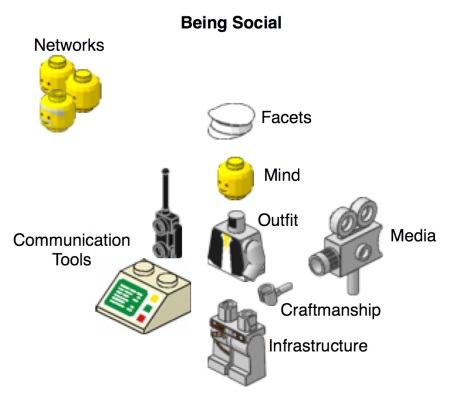The work practice amongst many Internet site-owners, intranet managers, content owners and communication’s professionals, tell the very same never ending story, that the prevailing CMS worldview is hampering their daily work practice. Why is this the fact still anno 2009? Independent of ‘brand of choice’ in the web content management sphere. Some better, some are less good, but the outstanding issues won’t go away that easy.
The work practice being a content editor cover three very simple steps: cope with the incoming business triggers that might become content or news [I,II,III], evaluate the story through social networking with peers and involved stakeholders [IV]; Second prepare the actual text, with good wordsmith practice including ‘clean up’ the incoming material from the providers. Usually through email conversations, using attachment and Word file, that needs to be run through the text formatting washing machine prior to entering it to the actual CMS editor environment. Topping this step comes the cumbersome process of putting the content into context with proper meta-data, tagging schemes and cross-linking before shooting it out into publishing mode [V]. Sometimes the techies have also added the workflow publishing purgatory before the editor actually will be able to view the content in context. Some less fortunate lost souls in the communicators/content editors network might even have to use user-unfriendly user-interface that stops them from actually ‘seeing/viewing’ the content before entering the workflow publisher purgatory. Not to mention, that cross-linking might be the content file share from hell quest, rather than easy link-in-context. Linking is probably one of the most hot-topics to any site owner. Everybody loves a cross-linked web, internally or externally, or if you are a robot from a well know search engine. However, being content editor puts you in a conflict with your own backyard trying to finish your story timely and skip deep linking.
The three main problem domains, in any CMS relate to these steps
- Collaboration prior to publishing the content
- Putting content in context
- Findability, derived from poor information architecture and management practice
New ways/waves of collaboration/conversation
Given the in-built features to Google Wave there are several positive options (when Google Wave will finally will be released, I have only done early trials as all of us in this space). When you work within a large corporate setting the networking amongst your peers is really a problem, even if you work within one and the same CMS. Regardless of CMS backbone, the lack of easy collaboration prior to publishing is always done in environments outside the actual CMS (read email threads and attachments). From the editors position this co-ordination of entries to content and reviews of peers or stakeholders is time consuming to say the least, but the built-in ‘lock-in’ thinking with both the CMS world per se, and email and MS Office document increases the headache. In my research, with in-depth on-site work sitting co-located with editors in global large corporations the last 4-5yrs, this has become one of my main contribution to my forthcoming dissertation. Content or news provision will often be lost in transmission. Obviously there are times when content creation needs to address closed settings, given the sensitive nature of the actual information, but the bulk load of work do not fit into this space. Hence, there is a great opportunity to open up the collaborative environment using Google Wave/Docs tinkering, instead.
The two main contributions to the quality of the content provision relates to decrease of coordination work keeping track of versions of the text circulating in the process. Second, with proven poor deep-linking status to many intranet or Internet sites this will be enforced, since the contributors will be able to add links on the fly in the provision process. When all collaboration and work-in-progress development is set and the editors finally enter the content base into the CMS (preferable through simple integration from the Wave to CMS world).
Lastly the open collaborative environment will make this work more transparent to other peers in the network, which is one core problem. You do not always know who too invite into the provision process. Many stories uncovered in my own publications shows exactly this backdrop to the CMS world. If you have more than 2000+ editors on a global scale it will become impossible to keep social ties in all levels, even if you share the very same work practice. All clusters/networks of editors do serve different parts of the business. In stark contrast to other commentators into this debate, I think the Wave infused CMS world will showcase its best performance in large scale implementations. Not to say that we are going to see 2000+ edits into one and the same Wave, but the flat structure to document creation and the open structure will enforce an much more precise delivery. I dare to say, that if the CMS world don’t reformat the old file share, container document equivalent mind-set they will become obsolete.
Future post into this space will continue the last two hot topics, ‘put in context and my special interest in findability 😉
I will report on on-site implementations of Wave and CMS integration forthcoming, since several of my clients and research domains do undertake early trials as we speak. Moving away from the traditional CMS space? Why give an ‘old school’ and outdated CMS to so many editors, when all they might actually need sits in simple tools like WordPress or Google Docs/Wave? What is the cost benefit analysis to this? I have worked with the counterpart of BIG brands in the CMS world, and they all fall into the very same snake pit, sadly!



 Posted by Fredric Landqvist
Posted by Fredric Landqvist 